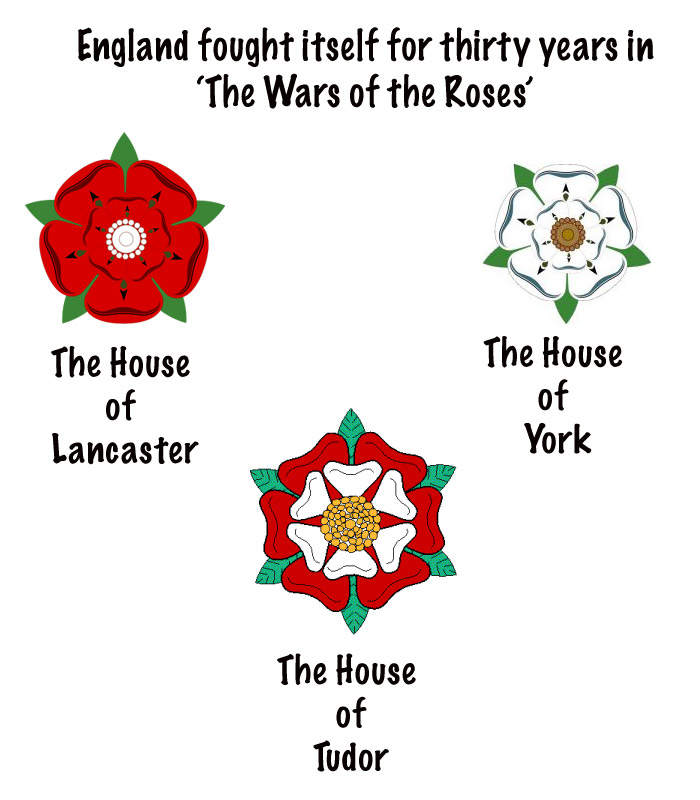- York, House of
- (1461–1470, 1471–1485)A branch of the royal family of Plantagenet, which had ruled England since 1154, the house of York and its partisans comprised one of the parties contending for the throne during the WARS OF THE ROSES.The family of York descended from Edmund, first duke of York (1341–1402), the fourth son of Edward III (r. 1327–1377). Because Richard II (r. 1377–1399), Edward III’s grandson and heir, was childless, the legal succession to the throne came to rest with the Mortimer family, descendants of Richard II’s eldest uncle (and Edward III’s second son), Lionel, duke of Clarence (1338–1368). However, in 1399, Henry of Bolingbroke, son of John of Gaunt, duke of Lancaster (1340– 1399), third son of Edward III, deposed his cousin Richard II and assumed the throne as Henry IV (r. 1399–1413), first king of the Lancastrian branch of the royal family (see Richard II, Deposition of).Because the Lancastrian usurpation of 1399 bypassed the proper heirs, several people had a claim to the Crown that was technically superior to that of the ruling dynasty. When the last direct Mortimer heir died in 1425, the family’s claim passed to their Yorkist cousins in the person of Richard PLANTAGENET, third duke of York, the son of Anne Mortimer (1390–1411). By the 1440s, York was informally recognized as heir presumptive to the (then) childless HENRY VI, third king of the house of LANCASTER. Although York made no claim to the throne, he did revive the royal family’s ancient surname of Plantagenet, perhaps to emphasize his right to a special position in his Lancastrian cousin’s government (see Plantagenet, House of). The Wars of the Roses emerged in the 1450s from the desire of York to rule on behalf of an incompetent Henry VI, an ambition that was thwarted for much of the decade by Queen MARGARET OF ANJOU and the clique of royal favorites who supported her. In 1460, when York finally made formal claim to the Crown, the queen’s faction coalesced around Henry VI as the core of the Lancastrian party, while the local rivals of Lancastrian courtiers and other nobles who felt excluded from power formed around York as the core of the Yorkist party. Although York failed to achieve his ambition, dying at the Battle of WAKEFIELD in December 1460, his eldest son, proclaimed as EDWARD IV, secured the throne at the Battle of TOWTON in March 1461. The civil wars revived in 1470 when an uneasy alliance between the Lancastrians and the NEVILLE FAMILY, former Yorkist allies led by Richard NEVILLE, earl of Warwick, briefly restored Henry VI (see Edward IV, Overthrow of). In the spring of 1471, Edward IV regained the throne at the Battles of BARNET and TEWKESBURY; the death at Tewkesbury of EDWARD OF LANCASTER, Prince of Wales, freed Edward IV to liquidate the direct male line of Lancaster by ordering the murder of the imprisoned Henry VI in May (see Henry VI, Murder of). After 1471, the Wars of the Roses appeared finished and the house of York seemed secure; however, the conflict reignited in 1483, and the dynasty fell from power in 1485. The downfall of York flowed from the death of Edward IV at age forty, in 1483, and the subsequent supersession and likely murder of his twelve-year-old son, EDWARDV, by the boy’s paternal uncle, who assumed the throne as RICHARD III (see Princes in the Tower; Usurpation of 1483). This usurpation created a coalition of former Lancastrians and dissident Yorkists around Henry Tudor, earl of Richmond, who, through his mother, Margaret BEAUFORT, inherited the Lancastrian claim to the Crown (see Beaufort Family). Richard III’s death at the Battle of BOSWORTH FIELD in 1485 ended Yorkist rule and enthroned Richmond as HENRY VII, first monarch of the house of TUDOR.Although Henry sought to unite the royal lines of Lancaster and York by marrying ELIZABETH OFYORK, daughter of Edward IV, the Tudor dynasty was actively menaced for over a decade by plots and invasions aimed at restoring the house of York. Centering on pretenders impersonating either a son of Edward IV or Edward PLANTAGENET, earl of Warwick, the last Yorkist claimant in the direct male line, these attempts were all unsuccessful (see Simnel, Lambert; Warbeck, Perkin). Hopes for a Yorkist restoration faded in the sixteenth century as Henry VIII, the second Tudor monarch and a grandson of Edward IV, gradually eliminated the children of Edward IV’s sisters and daughters (see Yorkist Heirs [after 1485]).Further Reading: Johnson, P. A., Duke Richard of York (Oxford: Clarendon Press, 1988); Ross, Charles, Edward IV (New Haven, CT:Yale University Press, 1998); Ross, Charles, Richard III (Berkeley: University of California Press, 1981).


Encyclopedia of the Wars of the Roses. John A.Wagner. 2001.
